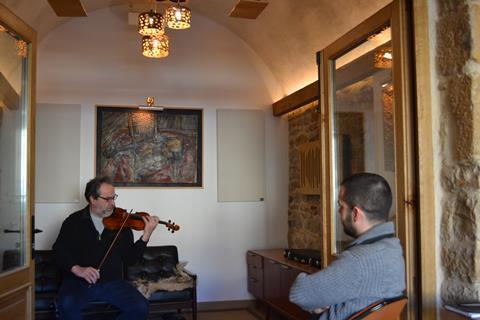- News
- For Subscribers
- Student Hub
- Playing Hub
- Directory
- Lutherie
- Magazine
- Magazine archive
- Whether you're a player, maker, teacher or enthusiast, you'll find ideas and inspiration from leading artists, teachers and luthiers in our archive which features every issue published since January 2010 - available exclusively to subscribers. View the archive.
- Jobs
- Shop
- Podcast
- Contact us
- Subscribe
- School Subscription
- Competitions
- Reviews
- Debate
- Artists
- Accessories
Making Matters: In tune with the types

Luthiers often examine a musician’s way of playing before setting to work on their instrument. David Leonard Wiedmer explains why it can be helpful to categorise players into two different ‘types’

Photo: David Leonard Wiedmer
David Leonard Wiedmer (right) studies the technique of violinist Manuel Solans as a prelude to making his new violin
In my opinion, the true aim of any violin maker is to make the best instrument for a particular musician. This involves finding and evaluating the wood, the model and the set-up that would best suit that player – a complicated issue given that there is no definitively ‘correct’ solution, any more than there is one perfect ‘ultimate’ violin. For a critical approach to violin making we certainly need to create our own theories, but if we follow them too strictly they can end up hindering our endeavours. I personally think that there comes a time in every luthier’s experience when they need to rely on their intuition rather than put their faith in fundamental rules. In other words, it’s important for us to understand those rules well enough to be able not to follow them.
For me, whenever I make a violin or a new set-up, I start by defining the type of violin player sitting in front of me. This basically falls into two categories. First, there are the players who try to make the violin ‘breathe’ as much as possible, and who need an instrument that is free to react. These musicians tend to use more bow and have a supple wrist. Secondly, there are the musicians who need to push to find the sound. They tend to have a more compact technique along with strong shoulders. For this article I’ll call the two types the ‘breathing’ musician and the ‘strong’ musician. Both types can reach the highest level, but each requires a different kind of instrument and set-up. With this in mind, I’ll listen to each musician play, and then try to work out how closely they fit into one of these types.
For the breathing musicians my standard violin will have the following features: flat arching, a narrow distance between the f-hole eyes, low string angle, Kevlar tailgut and ‘high-vibrating’ strings. This leads me on to another of my theories. To my mind, there are two categories of strings: the ‘high-vibrating’ ones, which have wide amplitude and exert less inertial force on the bridge, and the ‘strong-vibrating’ strings, with less amplitude but more force on the bridge. This is not a matter of string tension, but about the way the strings behave. I won’t go into string brands here, but readers will probably have an idea about which brands suit each category.

Photo: David Leonard Wiedmer
Left: Checking the soundpost position to find the correct tension for the top plate. Right: Finding the correct pressure on the violin by checking the string angle
For the strong musicians, I’ll opt for a high arching and good counter-curve before the fluting, with a wide distance between the f-hole eyes, higher string projection, a nylon tailgut and ‘strong-vibrating’ strings. The player type also influences my decisions regarding the making of a new instrument. Regarding the thicknessing of the top plate, for the breathing musicians I would make it finer around the fluting area compared to the rest of the plate, whereas for the strong musicians I would make it thicker. The list could go on: density, wood structure, soundpost thickness, string length and so on, but this at least gives a basic insight into my approach. Of course, this segregation into two types of player is a generalisation, but from this starting point I can build a better idea of how to unify the musician in front of me with the wood I have and the bow they use.
I think every musician wants good projection and a noble sound, which consists of depth and timbre. Some players are always more focused on finding as much depth as possible, so the instrument needs to have more timbre built in from the outset. And some prefer to search for the timbre, so they need a violin with depth. It all depends on their natural way of playing.
Already subscribed? Please sign in
Subscribe to continue reading…
We’re delighted that you are enjoying our website. For a limited period, you can try an online subscription to The Strad completely free of charge.
* Issues and supplements are available as both print and digital editions. Online subscribers will only receive access to the digital versions.




























